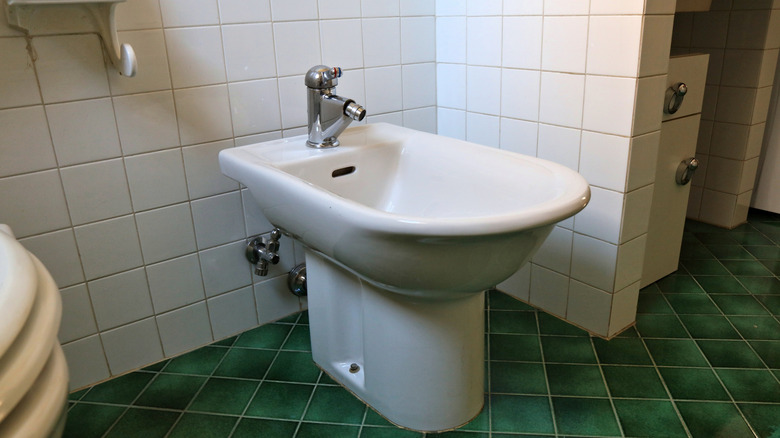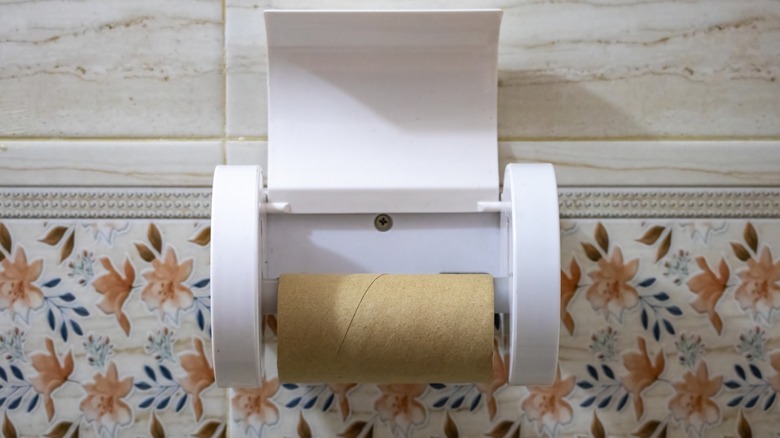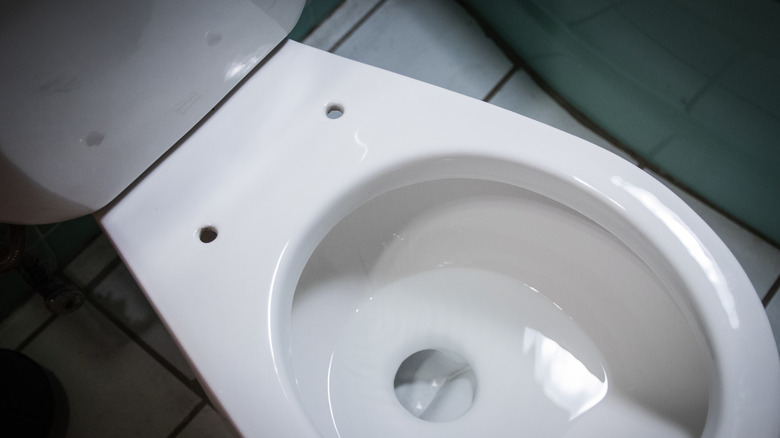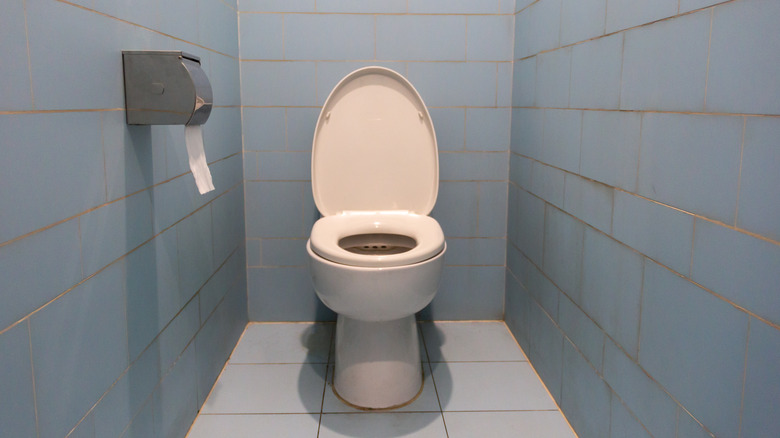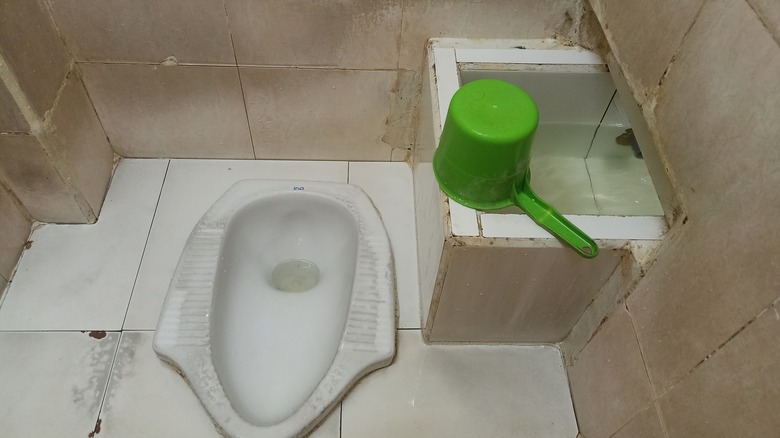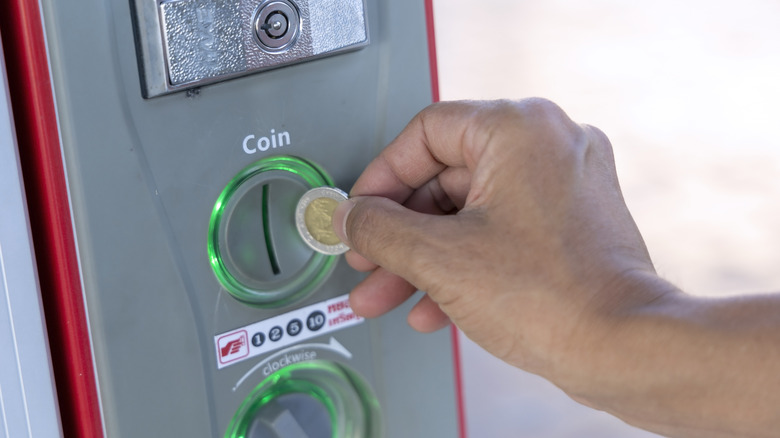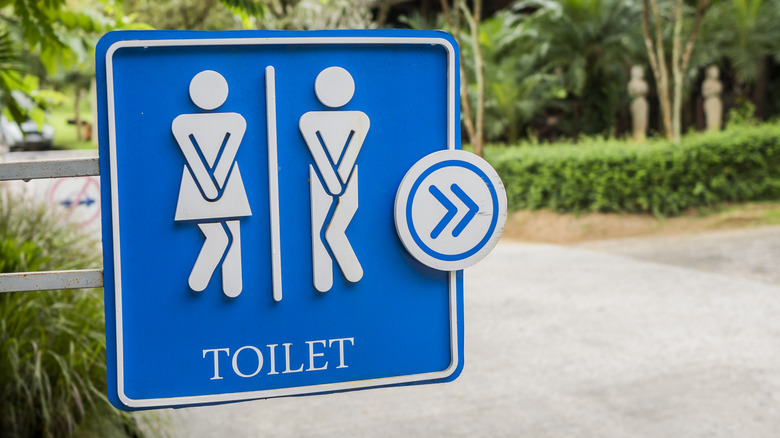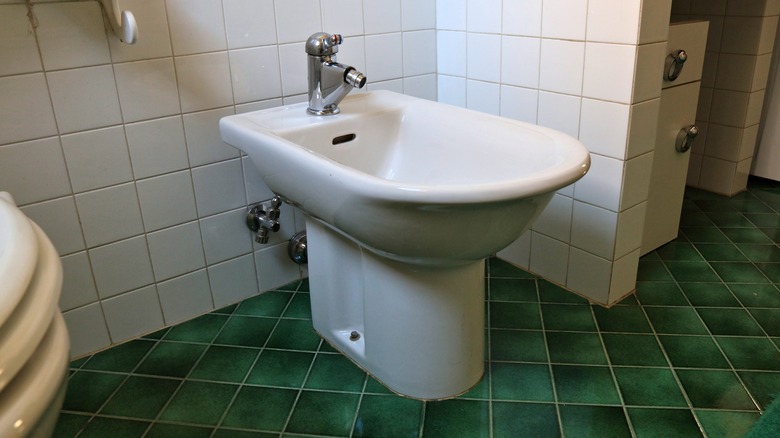Unspoken Bathroom Rules Tourists Need To Know Before Traveling To Italy
You could be forgiven for thinking that using the bathroom is an activity so universal that the idiosyncrasies of travel do not apply. True, few of us have failed to ponder the celebrity-endorsed, one-of-a-kind toilets of Japan. And, sure, most of us understand on an almost instinctive level that some tourist cities have worse public restroom access than others. But when it comes down to the brass tacks of the issue, the restroom is a place of biological necessity, and the less said about what goes on within them, the better.
Such notions serve as a theory, but they are of less practical use. In China, some 88% of people prefer to use a squat toilet. In much of Southern Europe, toilets don't flush; used paper goes into the bin provided. Russian public toilets are often built side by side without partitions, and in India, approximately one quarter of all rural households do not have any toilet facility whatsoever.
Meanwhile, over in Italy, the rules surrounding basic bathroom use are as complex as they are delightfully eccentric. They can take you on a journey, for sure, such as attempts to decipher the peculiar signage or exploratory dives into the inner workings of exotic flushing mechanisms. Such things cannot be intuited; they must be learned. Here, then, is everything you need to know about bathrooms in the Italian peninsula.
Bring your own toilet paper
Public services in Italy sometimes feel like an afterthought. There are unnecessary layers of bureaucracy to navigate, actual corruption in play, and enormous disparities between the rich and poor. Taking things for granted in Italy is one of those missteps that can derail an otherwise perfect vacation. Take toilet paper, for example.
In the U.S., 27,000 trees are felled for toilet paper production every day. The industry is worth $55 billion globally. Toilet paper is, after all, part of the dance, the ballet of ablutions, the Plié, the Allegro, the well-executed wiping of the bum. Such movements are of little use on their own. You use, you wipe, you flush. So, why, the disgruntled tourist may ask, are Italian restrooms so often devoid of the necessary supplies? It is due to factors ranging from a preference for alternative hygiene solutions — enter the bidet — to the plumbing and design inadequacies of older buildings.
To be clear, this isn't a universal issue. Hotels are well-stocked, as are most restaurants. Tourist cities with one eye on avoiding Tripadvisor rants keep their public spaces immaculate, and even in some rural areas, you'll find the odd roll or two. But is it a given? Absolutely not. You'll find small packets of toilet paper for sale in most convenience stores for this very reason. Italian cynicism predicts the legitimate horror of an empty dispenser with frightening accuracy at times. During such moments, the aphorism when in Rome comes into exceedingly sharp focus.
Always carry a seat cover with you
There is a myth that Italian city planners so refuse to throw good money after bad, that they only ever offer around three-quarters of what you'd expect from a toilet. The bowl is usually in situ; the flush, although often idiosyncratic, is generally there also. But the seat? Guess what? Italian toilets are notorious for failing to include one. It's not like the seat is optional.
First, it prevents contact with the bowl. Porcelain matches the bathroom's temperature, and as such, it is the last thing you want to feel with your bare flesh. Second, it allows you to flip the seat up, so the next person to arrive is spared the indignity of wiping it clean. Can you use a toilet without a seat? Sure. Has anyone ever wanted to? No. The truth is that on the day the toilets were fitted, the seat was a reassuringly non-optional extra. The Italian propensity for hygiene caused many patrons to stand on the seat in a quasi-acrobatic display of urgency. Breakages ensued. To complicate matters, the standardized shape so familiar elsewhere is an alien concept to most Italians.
Italy did not unify until 1861, and the old nation-states have very much stuck to their guns when it comes to design briefs. There are dozens of styles of seats and toilet shapes to choose from. That, added to the generally lackadaisical approach to governing, created something of a bottleneck. Once broken, the seat is such a pain to replace that in many cases, nobody seems to bother. The issue is prevalent even in the capital to the point where one of the best things you can do on a one-day trip to Rome is to bring a seat cover of your own.
Figure out the flush ahead of schedule
The same issue that led to the creation of hundreds of differently shaped toilet bowls has also affected another essential function of a toilet: the flush. The nation's long history of ceramic production crossed international lines before unification. Such prior fragmentation of ideas created novel solutions to otherwise mundane ways of making biological symphonies disappear.
The foot pedal is one of the more common anomalies you'll encounter. The stated idea is simply to keep sticky fingers away from a flushing mechanism that has been handled by people not unlike yourself. People, that is, who have just been to the bathroom but have yet to take the opportunity to wash their hands. The hygiene advantages are more than apparent, and yet, initial encounters with floor-operated flushing mechanisms have been known to take tourists by surprise. The pedal on the ground should not be messed with until the post business flurry of dressing has taken place, no matter how tempting it looks to your wandering feet. Pressing it while sitting down — and I'm speaking from experience here — is a bad, bad thing to do.
Other options you may encounter include buttons on the wall and pull cords in booths where the water closet itself is suspended high on the ceiling. Faucets also make use of pedals. In such cases, they will usually, though not always, be color-coded, with red indicating hot and blue signifying cold. Whether they work or not depends very much on the caliber of the selected facilities.
Learn to love the squat
Historically speaking, the quiet dignity of a private toilet was a long time in the making. Neolithic people living on Scottish islands with ruins that predate Stonehenge made do with stone-lined drains. In ancient Egypt, a stool with a hole cut through the middle and a tray of sand resting underneath was the best low-income folks could hope for. In Rome, public lavatories consisted of a line of seats with no partition between them. Still, at least you could sit down. For around half of the human population, that still isn't the case.
Around the world, some 4 billion people use squat toilets. Most commonly found in Africa, Asia, the Middle East, and South America, they do crop up from time to time in slightly more unexpected locations. Italy is one such place. Known locally as bagno alla turca — translating to a bath in the Turkish style in English — the existence of the squat in rural areas boils down to one part hygiene and two parts obsolete plumbing. Italy is, after all, an ancient place, and the intrinsic joy of living in an antediluvian house bursting with character is an exercise in trade-offs like no other.
You'll mostly find squat toilets in less touristy areas, especially in older buildings. Yes, they take some getting used to, and the less supple among us may struggle more than most. Still, purists who refuse to so much as contemplate using one should note that the squat approach brings with it several advantages. The adopted position aids in evacuation, may reduce digestive strain, and can act as a cure for constipation. Besides, there are places in Italy — looking at you, San Gimignano — where you don't have that much say in the matter.
Carry some change
A vacation to Italy is an experience like no other. The Mediterranean lifestyle encourages a somewhat lackadaisical approach to daily routines, and such laissez-faire attitudes influence all aspects of life on the peninsula. True, there are rules to follow, things tourists should never do on a visit to Italy, and yes, lists of essential travel hacks to consult. But for the most part, it's all about going with the flow. So long as you keep some spare change in your back pocket, that is. In Italy, coins act as security to any pressing biological urges you may encounter.
If you're not paying to use a public restroom in Italy, you aren't doing it right. The mystery of the missing seats, the sudden, unexpected lack of toilet paper? Such things are the province of poorly kept, rarely cleaned, and suspiciously compensation-free public conveniences. Indeed, a sign demanding a payment of €1.50 for the privilege of using a restroom is far from a thing to grumble about. The paid bathroom break in Italy is like manna from Olympus. You'll find them at train stations in Rome, Venice, and Sienna, at the Piazza Navona in Rome, and close to the Duomo in Milan.
In some cases, the restrooms are coin-operated. In others, you must pay an attendant directly. Places accepting cards are becoming increasingly common, but it's not a given. Cafés and bars tend not to charge for use of their facilities, but they certainly expect you to buy something first. It's cheaper to find a paid restroom in a nearby subway, of course, but not always as convenient, especially during rush hour. It's even cheaper to find a free one, but you've been warned.
Toilet paper is for the bin
The extent to which Italy is a progressive country, burdened or blessed with the infrastructure of the past, is one of those things best experienced firsthand. Taking time to explore the most breathtaking campsites in Tuscany, for example, reveals a land of cosmopolitan cities rich with the trappings of modernity. But you'll also find medieval hill towns so rooted in the past that their streets are too narrow for traffic. Some of the oldest villas you can stay in have taken the time to upgrade their facilities, yet elsewhere, there are whole villages that rely on wells for their daily water. Italy is an ancient place, filled with old customs and, at times, even older pipes. Enter the bathroom bin.
There are two reasons Italian homes prefer that used toilet paper goes into the trash can as opposed to down the bowl in anticipation of a quick flush. The first, and most obvious reason, stems from the use of the bidet — more on that later. The second reason is all down to the age of the plumbing itself. Built with lower water pressure in mind and narrow to boot, asking such Methuselah to handle toilet paper is too much of a request. Ignoring this reality leads to inevitable blockages.
Since wrestling with a plunger is low down on most people's lists of fun things to do on a vacation, this is something best avoided. The very presence of a small bin allows most Italians to sense that the flushing mechanism is all talk and no trousers. In tourist areas, however, signs, often in English, spell out the process. Ignoring such instructions is most inadvisable, as the quid pro quo you will receive for not doing so is the stuff of legitimate nightmares.
Playful signage
There is a conceit that signs are universal. There are internationally recognized symbols of danger. The yellow trifoil is for radiation. The skull and crossbones indicate the presence of hazardous chemicals. The dreaded slashed circle simply denotes no entry. Such signs were designed to be language independent, to convey meaning to the viewer without words, context, or cultural touchstones.
These signs are restricted to warnings. The green man on crossings translates to "go," the crossed-out cigarette means you aren't allowed to smoke, and the trousered man and skirted woman indicate that there are toilets nearby. Right? Well, sort of. The Italian propensity to do things in what can only be described as egregious — yet delightful — extends to their use of motifs. Tourists seeing a sign of two people with crossed legs might think that they are looking at a piece of pop art.
Such signs denote the presence of a bathroom facility, and the whimsy on display exists solely for amusement. And it does not stop there. There are signs of a man looking over a stall to peer into the ladies' section. You'll find mermaid and centaur varieties. Tourists should also make note of the difference between "Signore" and "Signori" signs. Any confusion that stems from the similar spelling may well be a deliberate trap at the expense of the unwary visitor. Meanwhile, the less said about the hand-painted ceramic gnomes bearing their butts, the better.
Embrace the bidet
The bidet is the one piece of bathroom equipment that is viewed with equal parts dread and suspicion by those not used to them. For those unfamiliar with the term, a bidet is a low basin with an angled faucet designed to wash your undercarriage after you've finished using the loo. Although they were first invented in France during the 18th century, people lost interest in them as time passed. The word "bidet" means "pony" in French. The Italians, however, developed something of an obsession.
Indeed, so deeply rooted is the Italian fascination with a post-ablution rinse that in 1975, the government passed a law requiring every Italian home to be fitted with one. Such actions bring some of the idiosyncrasies of Italian toilet etiquette into sharp relief. The lack of toilet paper, the desire to stand on seats, and the absence of urgency when it comes to upgrading the plumbing. Blame the bidet. Because, to the Italian mindset, a simple wipe is an underperformance of barbaric proportions. At home, each movement is accompanied by a wash; the toilet paper that ends up in the bin? It is for drying an already clean bottom.
Using a bidet for the first time takes more mental fortitude than it does actual practice. As the translation suggests, straddling the bowl is the way to go. The direction you face is a matter of personal choice, as is the selected temperature and water pressure with which you feel most comfortable. Once clean, wipe yourself dry with a tissue or towel, and congratulations, you've used an Italian bidet while simultaneously failing to destroy your host's plumbing in one fell swoop.
The three towel rule
Those who have made the transition from public restrooms to hotel lobby bathrooms and traditional Italian B&Bs will inevitably come across one last eccentricity. Simple enough to grasp, the unspoken towel rule visitors to Italy need to know about is nevertheless a bit of a doozy. The average Italian bathroom is a relatively small affair. Shower cubicles are reminiscent of telephone booths; baths are not always present, and the need for a bidet takes up serious real estate.
One thing you will always find, however, is a towel rack, and it is here that the three-towel rule comes into play. Each towel has a specific function delineated by its size. The smallest towel is often placed next to the bidet and is sometimes deliberately mismatched in color. It's intended solely for drying post-washed intimate areas that have been scrubbed clean through a combination of running water and pH-neutral soap. The medium-sized towel is for the hands and face exclusively; it must never be used interchangeably with the bidet towel. Lastly, there is the large towel, which, unsurprisingly, is for drying the body after a bath or shower.
These towels are changed daily; in some households, fresh towels are put out more often than that. Meanwhile, in hotels, guesthouses, and tourist areas where mistakes are rife, expect to find signs affixed to walls aimed at preventing potential errors. There is no real consequence to a refusal to use the system other than a slight incredulity from Italians who see the wisdom of their system. In their minds, sans bidet, showering after every toilet visit is the only hygienic option left to them. And not even the slow pace of the Mediterranean lifestyle has enough time for that.
